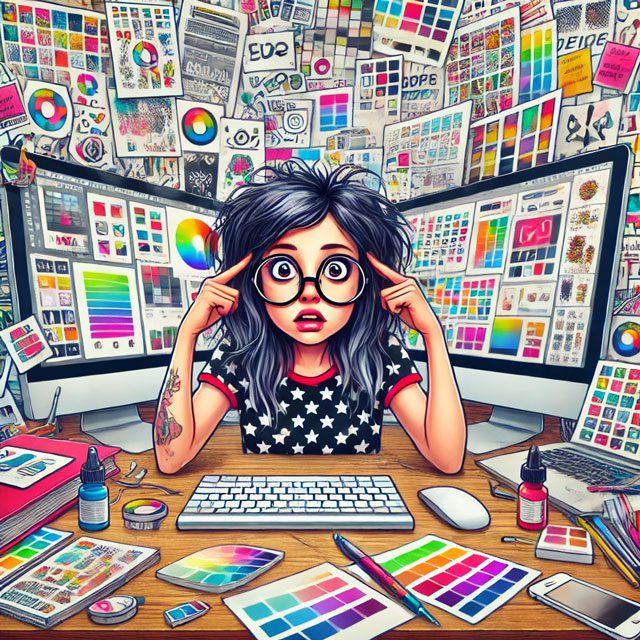
There’s a big problem in the world of graphic design, and it’s not what you’d expect. With so many new tools and apps, just about anyone can call themselves a designer. But here’s the thing: most of them have no idea what they’re doing. Hiring the wrong person to handle your brand’s design can be a disaster, leading to ugly logos, confusing websites, and marketing materials that make you cringe.
In today’s fast-paced, visual world, good design can make or break your business. But how do you separate the real professionals from the amateurs who just happened to download Photoshop? That’s what we’re here to help you figure out. By learning how to spot the warning signs, you can avoid wasting time and money on bad design work.
The truth is, a lot of amateur designers are hard to spot at first glance. They’ve got fancy portfolios, trendy social media accounts, and even the latest gadgets. But once you scratch the surface, it becomes clear they don’t really understand design fundamentals. Keep reading, and you’ll know how to avoid them before they damage your brand.
The Rise of the Amateur Designer
Thanks to software like Canva and other free tools, graphic design is now more accessible than ever before. These platforms make it easy for just about anyone to create something that looks decent. But here’s the catch: just because someone knows how to use a design tool doesn’t mean they know how to design.
A real graphic designer has years of experience, understands design principles, and knows how to apply them. The problem is, many people see these tools as a shortcut to becoming a designer. They skip the learning part and jump straight into freelance gigs, selling their services without the skills to back them up. According to the Bureau of Labor Statistics, graphic design is one of the fastest-growing freelance professions, but that doesn’t mean all these new designers are good at what they do.
Social media has only made this problem worse. Platforms like Instagram and Pinterest are flooded with “designers” showing off their latest work. It’s easy to get caught up in the hype of pretty posts and trendy layouts, but don’t be fooled. Many of these people are simply copying what they see online, without any understanding of why good design works.
What’s more, the rise of freelance platforms like Fiverr and Upwork has led to a boom in amateur designers selling their services. With competition high and prices low, it’s easy for anyone to claim they’re a designer, even if they’ve never worked with a real client. Businesses looking for a quick design solution often fall into this trap, thinking they’re getting a bargain, when in reality, they’re setting themselves up for failure.
Poor Communication Skills
One of the first signs you’re dealing with an amateur designer is poor communication. Professionals understand that design is about more than just making things look good. It’s about solving problems and helping a business succeed. To do that, designers need to have a clear understanding of their client’s goals, audience, and brand identity.
If a designer can’t explain their process or why they’ve made certain design choices, that’s a huge red flag. Communication is key to a successful project. When a designer doesn’t ask questions or tries to rush through discussions, it shows they’re not fully invested in the project. You might get a design that looks pretty, but it won’t align with your business needs.
Good designers know how to listen to feedback and make adjustments based on the client’s input. They don’t get defensive when you ask for changes, and they can explain why certain design elements are important. On the flip side, if a designer can’t articulate their vision or avoids conversations about your business, you’re in trouble.
An easy way to test a designer’s communication skills is to ask them to walk you through their previous work. A professional should be able to explain the thought process behind each design, why they made specific choices, and how those decisions supported their client’s goals. If they struggle to give you clear answers, that’s a sign they may not be as experienced as they seem.
No Portfolio or an Inconsistent One
Every good designer has a portfolio. It’s their best tool for showing off their work and convincing potential clients they know what they’re doing. But here’s the thing: not all portfolios are created equal. An amateur’s portfolio will often be inconsistent or, worse, nonexistent.
When reviewing a portfolio, you should be looking for a few key things. First, there should be a variety of projects across different industries. A designer who only shows work for one type of business might be stuck in a creative rut. Good designers can adapt their style to fit any brand’s needs.
Second, the work should be high-quality and consistent. If some pieces look polished while others seem amateurish, that’s a warning sign. A real professional won’t have wild swings in quality. Everything in their portfolio should reflect a certain level of skill and attention to detail. If you’re seeing a lot of the same design techniques or styles repeated, that’s another red flag. It could mean the designer is relying on templates or doesn’t know how to create custom solutions for each client.
Finally, pay attention to case studies or project descriptions. A professional designer will include details about each project, explaining the problem they were solving and how their design helped achieve the client’s goals. Amateurs, on the other hand, often skip this part, either because they don’t understand it or because they didn’t really solve any problems.
Relying Too Much on Trends
Trends can be exciting. They keep design fresh and fun, but there’s a danger in relying on them too much. Amateur designers often latch onto trends because they don’t have a deep understanding of design principles. They see what’s popular and copy it without considering whether it’s right for your brand.
The problem with trends is that they come and go. What’s cool today might be outdated in a year, and if your designer doesn’t think long-term, you’ll be stuck with a look that ages poorly. A good designer knows how to balance trends with timeless design elements. They’ll incorporate what’s modern while ensuring your brand identity remains strong over time.
One common trend mistake amateurs make is using flashy elements just because they’re trendy. Whether it’s overly stylized fonts, excessive gradients, or wild color schemes, these choices can hurt your brand if they don’t align with your message. For example, neon colors might be trending, but if your brand is all about luxury and sophistication, those colors will send the wrong message.
Experienced designers think beyond what’s popular in the moment. They consider your brand’s story, your audience, and the market you’re in. While they might use a trend here and there to keep things fresh, they’ll never let it take over the entire design. A design that works for your brand today should also work five years from now.
Ignoring the Brief
A design brief is like a roadmap for a project. It lays out the client’s goals, target audience, and desired outcomes. But some amateur designers treat the brief as a suggestion, not a guideline. They either don’t fully understand the brief or they choose to ignore it altogether, thinking they know better than the client.
This attitude can lead to designs that completely miss the mark. For example, if you’re launching a new product aimed at young professionals, and the designer delivers a cartoonish logo that looks like it’s meant for kids, it’s clear they didn’t follow the brief. A good designer takes the time to understand your needs and checks in with you throughout the project to make sure they’re on the right track.
Amateur designers often skip this step because they lack experience working with real clients. They might assume that they can just create something pretty, and that will be enough. But real design is about solving problems, not just making things look good. If a designer doesn’t understand your business goals, they can’t create something that will actually help you succeed.
The best way to avoid this issue is to make sure your designer asks questions. They should want to know everything about your business, your competition, and your target audience. If they don’t, that’s a sign they’re not fully invested in the project. Designers who care about their work will always be curious about your brand and how they can best support it.
No Knowledge of Typography or Color Theory
Typography and color theory are fundamental aspects of design, but many amateurs overlook them. They might throw together a few fonts and colors without any real thought, resulting in a design that looks chaotic and unprofessional. A good designer, on the other hand, understands how to use these elements to create harmony and balance in a design.
Bad typography choices are one of the easiest ways to spot an amateur designer. If you see a design with Comic Sans or Papyrus, run the other way. Professional designers know which fonts work well together and which ones don’t. They understand the importance of readability and how to use typography to convey a brand’s tone and personality.
Similarly, color theory is crucial in design. The colors a designer chooses can evoke specific emotions and set the mood for your brand. An amateur might pick colors based on what looks cool or what’s trending, but a professional knows how to use color to communicate your brand’s message. For example, red can create a sense of urgency, while blue tends to be calming and trustworthy.
If your designer doesn’t seem to have a solid grasp of typography and color theory, it’s time to reconsider. These are basic skills that every good designer should have. Without them, you’re likely to end up with a design that’s visually confusing and fails to connect with your audience.
Inability to Adapt Across Mediums
A real designer should be able to create work that looks good across all platforms. Whether it’s digital, print, or packaging, a design needs to hold up under different conditions. Unfortunately, many amateurs struggle to adapt their designs to different formats. They might create something that looks great on a website, but when you try to print it, the colors are off or the design looks blurry.
Designing for digital is not the same as designing for print. Digital designs are often more flexible, while print requires precision and attention to detail. A designer who only knows how to work in one medium is limiting your brand’s potential. You want someone who can create a cohesive brand identity that works everywhere, from your website to your business cards to your product packaging.
One common mistake amateurs make is ignoring resolution and file formats. They might deliver a low-resolution image that looks fine on a screen but turns out pixelated in print. Or they might not understand the importance of color calibration, leading to designs that don’t match your brand’s colors when printed.
When hiring a designer, make sure they have experience working in both digital and print formats. Ask to see examples of their work across different mediums. If they can’t show you a range of projects, that’s a sign they might not have the skills you need.
Brand Identity Damage
Bad design doesn’t just look ugly—it can actually harm your brand’s reputation. People form opinions about your business based on the visuals they see. If your logo looks amateurish or your website is confusing, potential customers will assume your business is the same way. First impressions matter, and poor design can create a lasting negative impression.
For example, a poorly designed logo can make your business look unprofessional. If the logo is too complex, hard to read, or uses the wrong colors, it won’t resonate with your audience. Worse, it could confuse them about what your brand stands for. A professional designer knows how to create a logo that’s both simple and impactful, leaving a positive impression on your audience.
Consistency is another key aspect of brand identity. If your marketing materials don’t look cohesive, people will notice. Maybe your website uses one set of colors, but your social media graphics use a completely different style. This inconsistency can make your brand seem disorganized and unreliable. A professional designer will make sure that all of your visual elements work together to create a unified brand image.
Your brand’s visuals should tell a story. They should reflect your values, your mission, and your audience’s needs. When amateur design enters the picture, that story gets muddled. To avoid damaging your brand’s identity, it’s crucial to invest in a designer who understands the big picture and can create visuals that truly represent your business.
Increased Costs in the Long Run
When you hire an amateur designer, it might seem like you’re saving money. After all, they often charge less than professionals. But what seems like a bargain at first can end up costing you a lot more in the long run. Bad design can lead to expensive fixes, lost customers, and even the need for a complete rebrand.
Let’s say you hire an inexperienced designer to create your website. It looks fine at first, but soon you realize that the user experience is terrible. Customers can’t find what they’re looking for, and your bounce rate skyrockets. Now, you have to hire another designer to fix the problem, costing you even more money than if you’d hired a professional from the start.
The same goes for branding materials. If your logo doesn’t resonate with your audience or your marketing materials don’t drive engagement, you’ll have to go back to the drawing board. Rebranding is not only expensive but also time-consuming. Every time you change your brand’s visuals, you risk confusing your customers and losing the brand recognition you’ve worked hard to build.
Investing in good design from the beginning can save you a lot of headaches later on. It ensures that your brand is represented accurately and consistently, helping you avoid costly mistakes down the road.
Customer Confusion
When your design is all over the place, it’s not just bad for your brand—it’s confusing for your customers. Amateur designers often create visuals that don’t align with your message, making it hard for customers to understand who you are and what you offer. This lack of clarity can lead to lost sales and missed opportunities.
For example, if your website’s design doesn’t match the tone of your business, customers might get the wrong impression. A luxury brand with a cheap-looking website will lose credibility fast. On the flip side, a casual, approachable business with an overly formal design could turn potential customers away. Your visuals need to communicate the right message to the right audience, and a professional designer knows how to do that.
Customer confusion can also stem from inconsistent branding. If your social media posts, website, and printed materials don’t look like they belong to the same company, customers will be left scratching their heads. They might wonder if they’re even in the right place. Consistency is key to building trust and recognition with your audience, and it’s something that amateur designers often overlook.
In today’s competitive market, you can’t afford to confuse your customers. Clear, consistent design is essential for guiding people through the customer journey and making sure they understand what your brand is all about.
A Solid, Versatile Portfolio
A designer’s portfolio is their calling card, and it should showcase a variety of high-quality work. When you’re looking to hire a designer, the portfolio is one of the most important things to review. But you have to know what to look for. A great portfolio will feature projects from different industries, showing that the designer can adapt their style to suit any brand.
You want to see a mix of work, from logos and websites to packaging and marketing materials. This versatility is key because it shows that the designer can handle a range of challenges. A one-trick pony who only does one style of design might not be able to give your brand the unique look it needs.
Another thing to watch for is the level of detail in the portfolio. Good designers will often include case studies or explanations of each project. They’ll walk you through the design process, explaining the client’s goals and how their design helped achieve those goals. This shows that the designer isn’t just making things look pretty—they’re solving problems and adding real value to their clients’ businesses.
Finally, pay attention to the quality of the work itself. Does it look professional? Is it cohesive? If the designs feel amateurish or inconsistent, that’s a major red flag. A professional designer takes pride in their portfolio and only showcases their best work.
Understanding of Design Principles
Design principles are the foundation of any good design, and a real professional knows them inside and out. These principles include things like balance, contrast, hierarchy, and alignment. When used correctly, they create designs that are visually appealing and easy to understand.
For example, balance refers to how elements are distributed in a design. A well-balanced design feels stable and harmonious, while an unbalanced one can feel chaotic. Contrast, on the other hand, is about creating visual interest by using differences in color, size, or texture. Without contrast, a design can look flat and uninteresting.
Hierarchy is another important principle. It refers to how information is organized in a design, with the most important elements being the most prominent. A good designer knows how to guide the viewer’s eye, making sure they see the most important information first.
If a designer doesn’t seem to understand these principles, it’s a clear sign they lack the skills needed for professional work. A well-designed project isn’t just about aesthetics—it’s about functionality and communication. Good designers use these principles to create designs that not only look great but also serve a purpose.
Collaboration and Receptiveness to Feedback
A good designer is someone who can collaborate with clients and take feedback in stride. Design is a process, and it often involves multiple rounds of revisions before the final product is ready. If a designer is resistant to feedback or gets defensive when you ask for changes, that’s a sign of trouble.
The best designers see feedback as an opportunity to improve. They understand that the client’s input is valuable and that working together leads to better results. If a designer pushes back on every suggestion or tries to steer the project in their own direction without considering your needs, they’re probably not the right fit.
Collaboration also means being open to new ideas. A professional designer will listen to your vision and work with you to bring it to life. They won’t just follow a template or give you something cookie-cutter. Instead, they’ll take the time to understand your brand and create something unique that truly represents your business.
Thinking Beyond Aesthetics: Strategy and Goals
Good design is more than just making something look nice. It’s about creating visuals that support your business goals and help you connect with your audience. A real designer thinks strategically, considering the bigger picture of how your design will be used and what it needs to accomplish.
For example, a website isn’t just a collection of pretty pages—it’s a tool for attracting customers and driving conversions. A professional designer knows how to design with these goals in mind, making sure the site is user-friendly, visually appealing, and optimized for search engines. Similarly, a logo isn’t just a random graphic—it’s the face of your brand, and it needs to communicate your values and identity clearly.
Amateur designers often focus too much on aesthetics and not enough on strategy. They might create something that looks good in isolation but doesn’t work in the real world. A professional, on the other hand, will take the time to understand your business and create a design that aligns with your long-term goals.
Attention to Detail
Great designers pay attention to the little things. Whether it’s the spacing between letters or the alignment of elements, every detail matters. Small mistakes can make a big difference in how professional your design looks. A designer who doesn’t focus on these details will produce work that feels sloppy and unfinished.
For example, something as simple as inconsistent spacing between letters (called kerning) can make a logo look amateurish. Misaligned elements or uneven margins can make a design feel chaotic, even if the overall concept is solid. These are things that the average person might not consciously notice, but they have a big impact on the overall quality of the design.
Professionals know that the devil is in the details. They take the time to fine-tune every aspect of their work, ensuring that everything is polished and cohesive. This level of attention to detail is what separates good design from great design.
Ask the Right Questions
When hiring a designer, it’s important to ask the right questions. Start by asking them to walk you through their design process. A good designer will have a clear, structured approach that they can explain to you. They should be able to tell you how they start a project, how they gather information, and how they make design decisions.
You should also ask for examples of how they’ve solved problems for past clients. Design is about more than just making things look pretty—it’s about finding solutions. A professional designer should be able to give you examples of how their work helped a business achieve its goals, whether that’s through increased sales, better brand recognition, or improved customer engagement.
Check References and Testimonials
One of the best ways to ensure you’re hiring a good designer is to check their references. Ask for testimonials from past clients and take the time to follow up. A real professional will have a list of satisfied clients who can vouch for their work. If a designer can’t provide references or seems hesitant to let you speak with their past clients, that’s a red flag.
Testimonials are also valuable because they give you insight into what it’s like to work with the designer. You’ll get a sense of how they communicate, how they handle feedback, and how well they meet deadlines. A glowing testimonial is a good sign that the designer is reliable and professional.
Don’t Just Rely on Price
It’s tempting to choose a designer based on price, especially if you’re on a tight budget. But remember, you get what you pay for. The cheapest option might seem like a good deal, but it could end up costing you more in the long run if the design isn’t up to par.
That said, the most expensive designer isn’t always the best, either. Look for a designer who offers good value for the price. That means they should have a solid portfolio, strong communication skills, and a clear process for delivering high-quality work. Focus on finding a designer who fits within your budget but also meets your needs in terms of expertise and professionalism.
Trial Projects and Clear Contracts
One way to test a designer’s skills is to start with a small trial project. This could be something like creating a social media post or designing a business card. A trial project allows you to see how the designer works without committing to a larger project right away. It’s a great way to assess their skills and determine if they’re a good fit for your brand.
Once you’re ready to move forward, make sure you have a clear contract in place. The contract should outline the scope of the project, the timeline, the deliverables, and the payment terms. Having everything in writing protects both you and the designer and ensures that everyone is on the same page.
Conclusion
Hiring the right graphic designer is one of the most important decisions you can make for your brand. The wrong choice can lead to poor designs that confuse your customers, damage your reputation, and cost you more money in the long run. But by knowing what to look for and asking the right questions, you can find a designer who will help your brand shine.
As Paul Rand, the legendary designer behind logos like IBM and ABC, once said, “Design is the silent ambassador of your brand.” Choose your ambassador wisely, and your brand will thank you for it.







